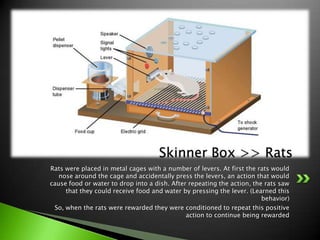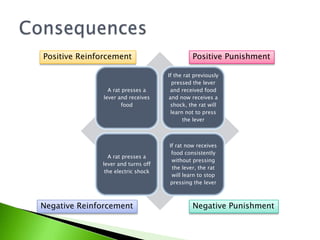B.F. Skinner
- 1. BurrusFrederic SkinnerProponent of Operant Conditioning
- 2. Born March 20, 1904 – Died August 18, 1990 of leukemiaFrom a small Pennsylvania town of Susquehanna His father was a lawyerHis mother was a housewifeReceived his BA in English from Hamilton College in upstate New YorkSkinner started his career as an English major, writing poems and short stories. After this...Skinner attended Harvard where he got his masters in psychology (1930) and his doctorate (1931), and stayed there to do research until 1936. Studied in the field of psychology (Behaviours) B.F. Skinner
- 3. Skinner married Yvonne Blue in 1936 and they had their first child, Julie, in 1938. In 1944, during World War II, Skinner worked on the “Project Pigeon” which trained pigeons to direct bombs by pecking at a target.In 1943, when Yvonne was pregnant for the second time, Skinner designed the “baby tender,” a crib that was designed to be safer than a normal crib.B.F. Skinner
- 4. baby tender
- 5. The illustration shows how a mouse can learn to manoeuvre through a maze. the mouse is rewarded with food when it reaches the first turn in the maze (A). Once the first behavior becomes ingrained, the mouse is not rewarded until it makes the second turn (B). After many times, the mouse must reach the end of the maze to receive its reward.
- 6. Skinner Box >> RatsRats were placed in metal cages with a number of levers. At first the rats would nose around the cage and accidentally press the levers, an action that would cause food or water to drop into a dish. After repeating the action, the rats saw that they could receive food and water by pressing the lever. (Learned this behavior)So, when the rats were rewarded they were conditioned to repeat this positive action to continue being rewarded
- 7. Skinner Box >> PigeonDuring World War II (1944) there were no missile guidance systems so Skinner decided to try and discover one. Skinner got funding for a top secret project to train pigeons to guide bombs. He trained pigeons to keep pecking a target that would hold a missile onto a target. The pigeons pecked reliably, even when falling rapidly and working with warlike noise all around them. (Learned behavior)Skinner trained the pigeon’s to peck at a particular colored disk
- 8. Consequences
- 10. Schedules of ReinforcementContinuous Reinforcement: Every time the rat does the appropriate behavior, he gets a pellet. Fixed ratio schedule: If the rat presses the pedal three times, he gets a pellet…or five times, or twenty times, or x times. There is a fixed ratio between behaviors and reinforcers. Fixed interval schedule: If the rat presses the bar at least once during a particular period of time, say 20 seconds, he gets a pellet. But whether he presses the bar once or a hundred times within that 20 seconds, he only receives one reinforcer. Variable ratio schedule: You change the x each time. First it takes 3 presses to get a pellet, then 10, then 4, etc. Variable interval schedule: You keep changing the time period. First 10 seconds, then 35, then 5, then 40.
- 11. Punishment
- 12. ConsequencesPositive ReinforcementPositive PunishmentNegative ReinforcementNegative Punishment
- 13. Technique of reinforcement used to teach new behaviors.At the beginning, people/animals are reinforcement for easy tasks, and then increasingly need to perform more difficult tasks in order to receive reinforcement.ShapingOriginally the rat is given a food pellet for one lever press, but we gradually increase the number of times it needs to press to receive food, the rat will increase the number of presses.
- 14. The elimination of the behavior by stopping reinforcement of the behaviorExtinctionA rat who received food when pressing a bar, receives food no longer, will gradually decrease the amount of lever presses until the rat eventually stops lever pressing.
- 15. A behavior may be performed in more than one situation.GeneralizationA rat who receives food by pressing one lever, may press a second lever in the cage in hopes that it will receive food. It is the tendency for a stimulus that is similar to the original conditioned stimulus to elicit a response that is similar to the new stimulus
- 16. Why is it important to the social sciences?Knowing how people learn behavior is a necessity to our society so that we can control and promote the good behavior, which will benefit society as a whole.The theory of operant-conditioning helps us to control the way humans learn behavior and how society can be a great influence on behaviorHelps us to understand how to improve behaviors (people with problem behaviors and criminal histories)
- 17. the endJC de Egurrolajeelchristine@i.ph

















